Tom's Hardware Verdict
The Kratos M1-750W is best suited for users prioritizing RGB flair over performance. While its design appeals to gamers, its aging platform, mediocre power quality, and noise levels under load severely limit its purpose. At its sale price, it may attract budget builders, but numerous higher-performance alternatives exist.
Pros
- +
Stylish RGB lighting
- +
Affordable at sale price
- +
Acceptable under light loads
Cons
- -
Mediocre power efficiency
- -
Noisy at higher loads
- -
Aged platform and basic components
- -
Poor cross-load performance
- -
No 12VHPWR/12V-2x6 connector
- -
Limited future-proofing
Why you can trust Tom's Hardware
GAMDIAS, a substantial player in the realm of PC power and cooling components, has consistently garnered attention for its innovative approach to crafting gaming hardware solutions. The company emerged on the scene in 2012. Despite its relatively short history, this Taiwanese manufacturer has rapidly gained international recognition, positioning itself as one of the freshest yet promising names in the world of gaming peripherals and PC components.
In a market teeming with options, GAMDIAS have strategically honed their focus on the gaming sector, navigating the intricate balance between cost-effectiveness and ostentatious design. The company offers a wide range of PC power & cooling products, as well as peripherals and even furniture, all of which are designed to gratify a part of the gaming community.
Today, our attention is directed towards a product that targets a very specific segment of the PC gaming market - the Kratos M1-750W PSU. While it may not bear the mantle of a flagship product designed for elite competition with the best PSUs, the M1-750W PSU, currently just $59, represents GAMDIAS' venture into the territory where aesthetics is the primary selection feature. As we delve deeper into its intricacies, we will explore how GAMDIAS tries to strike a balance between cost and visual flair, making the Kratos M1-750W PSU a viable proposition for users who seek prodigal appearance and RGB lighting without breaking the bank.
Specifications and Design
| RAIL | +3.3V | +5V | +12V | +5Vsb | -12V |
| MAX OUTPUT | 20A | 20A | 60A | 2.5A | 0.3A |
| Row 2 - Cell 0 | 130W | 130W | 720W | 12.5W | 3.6W |
| TOTAL | 750W | 750W | 750W | 750W | 750W |
| AC INPUT | 100 - 240 VAC, 50 - 60 Hz | 100 - 240 VAC, 50 - 60 Hz | 100 - 240 VAC, 50 - 60 Hz | 100 - 240 VAC, 50 - 60 Hz | 100 - 240 VAC, 50 - 60 Hz |
| MSRP | $60 | Row 5 - Cell 2 | Row 5 - Cell 3 | Row 5 - Cell 4 | Row 5 - Cell 5 |
In the Box
We received the GAMDIAS Kratos M1-750W PSU in a cardboard box featuring an impressive external design. All of the core features of the unit are printed on the front, with detailed information on the sides and rear of the box. The box itself is sturdy but there is no additional packaging inside to protect the unit, which is merely wrapped in a nylon bag. This could result in a number of products arriving DOA, as there is no cushioning to dampen any significant bumps and consistent vibrations.
Expectedly, the bundle of the Kratos M1-750W is Spartan, limited to just the necessary AC power cable, mounting screws, and a few cable ties. At the price range this unit is being targeted to, even the cable ties are an unforeseen luxury.
| Connector type | Hardwired | Modular |
|---|---|---|
| ATX 24 Pin | 1 | - |
| EPS 4+4 Pin | 2 | - |
| EPS 8 Pin | - | - |
| PCI-E 5.0 | - | - |
| PCI-E 8 Pin | 4 | - |
| SATA | 5 | - |
| Molex | 2 | - |
| Floppy | 1 | - |
External Appearance
The external appearance of the Kratos M1-750W certainly is unique even without its lighting on, with the company punching a pattern of their triangular logo on every side of the chassis, except from its top. The chassis measures 140 mm long, adhering to the ATX design guide recommendations and making it compatible with any ATX-compliant case. This PSU is not modular and every cable is hardwired to the unit. GAMDIAS is using flat, ribbon-like black wires and black connectors.
GAMDIAS placed the large sticker with the unit’s electrical specifications and certifications on the top side of the chassis. Simple decorative stickers featuring the company and PSU series logos can be found covering most of the surface area on both sides of the chassis.
Get Tom's Hardware's best news and in-depth reviews, straight to your inbox.

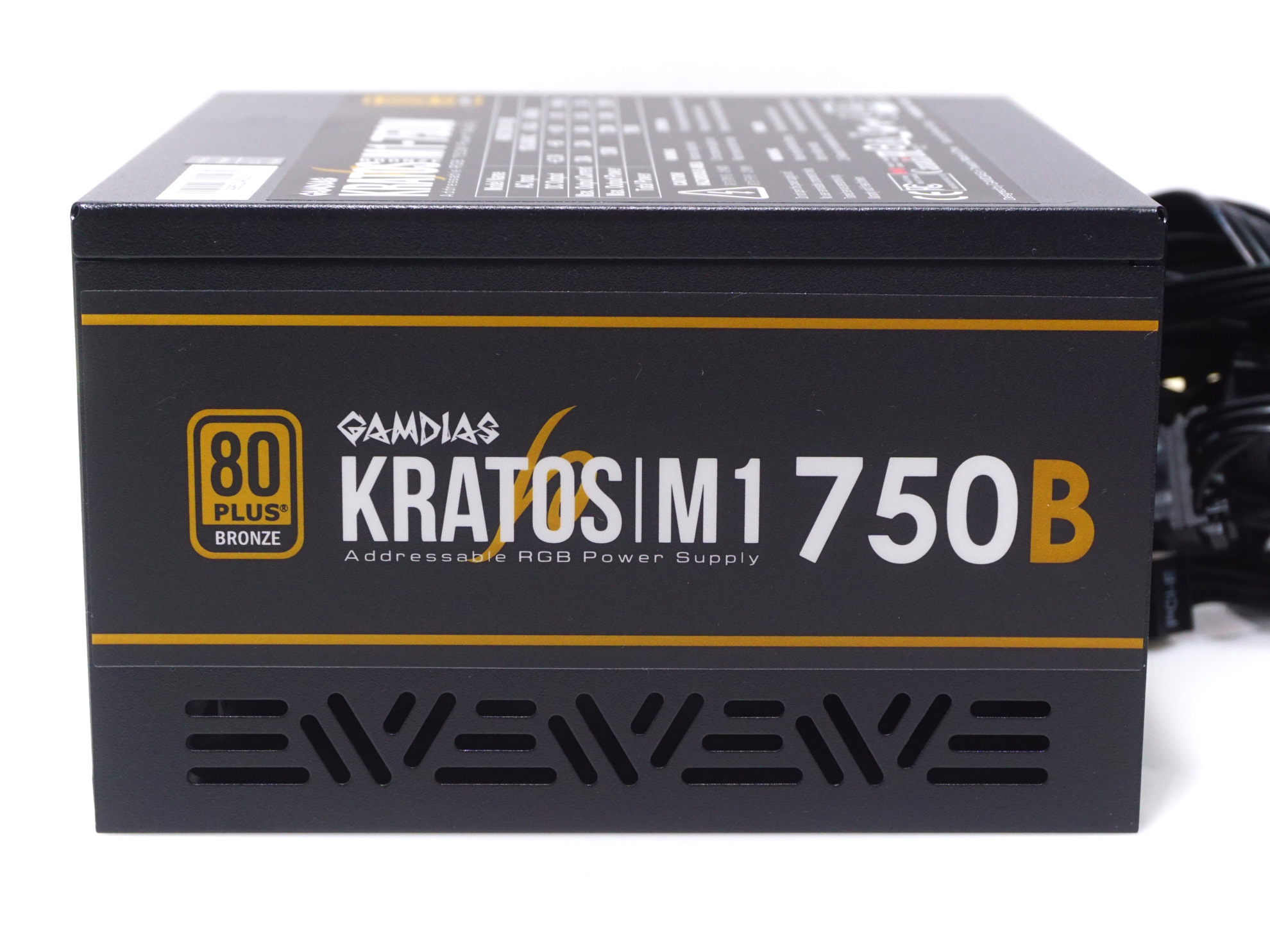
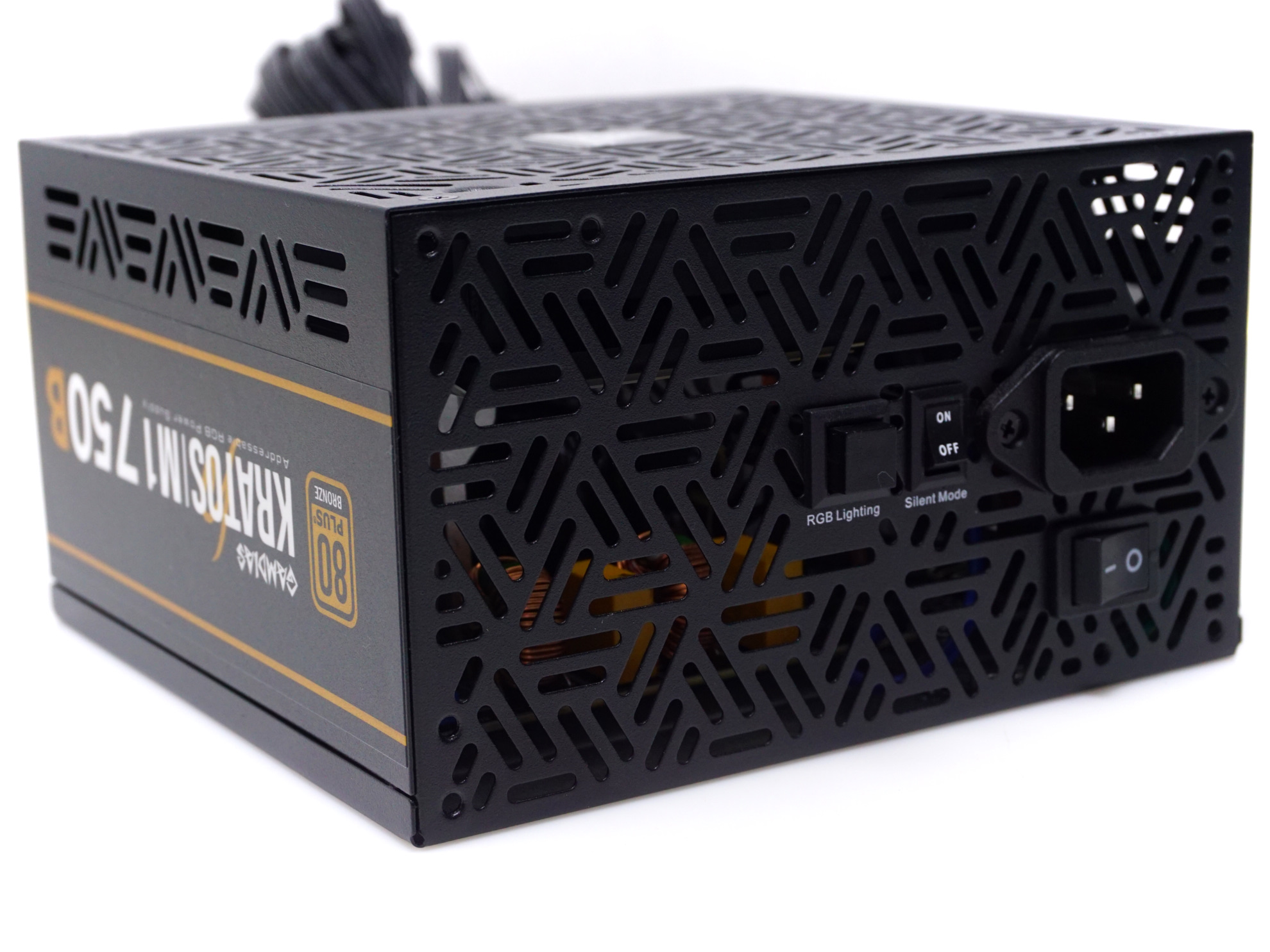
As the Kratos M1-750W is not modular, the front side of the chassis is entirely plain. On the rear side however, aside from the typical power cable receptacle and on/off switch, there are two more switches – one that circles through lighting patterns and one that toggles on/off the unit’s “silent mode”. Typically, we would expect the “silent mode” switch to be turning on/off the semi-passive thermal profile of a unit but this is not the case here. The Kratos M1-750W has no semi-passive mode and the fan of the unit will always spin, with the silent mode being the unit’s typical thermally-based fan speed control mode. Turning that off will simply force the fan to maximum speed regardless of the load.
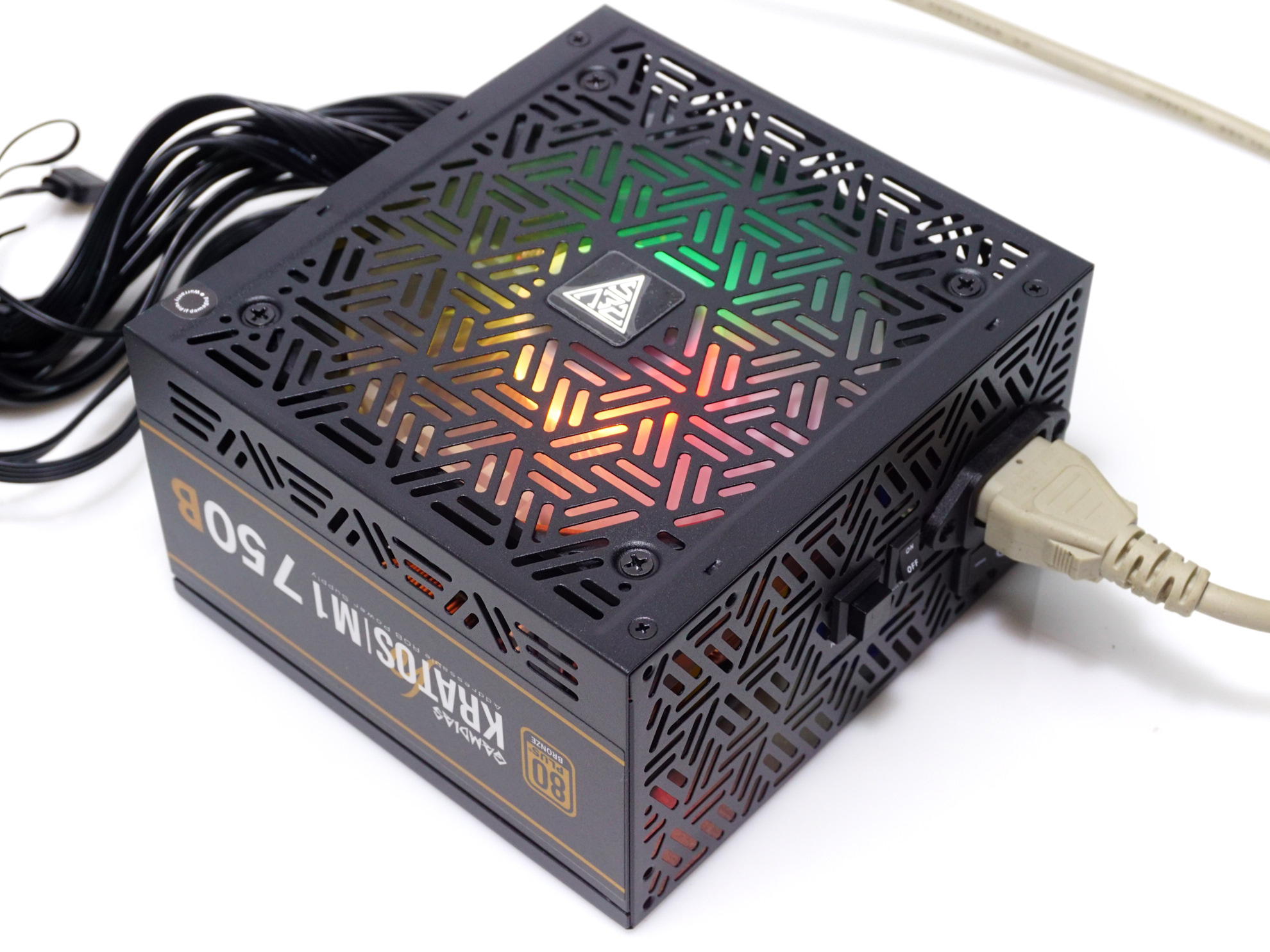


The prime selling point of the Kratos M1-750W is its external design and RGB lighting. Although the RGB LEDs are all inside the fan’s hub, they are fairly powerful and crisp, creating a strong visual effect. There is a large number of effects users can cycle and select using the switch at the rear of the unit but the LEDs also are addressable, allowing customization if the unit is connected to a compatible motherboard or LED controller (5V Digital RGB Header). Users can switch the RGB control input from internal to motherboard/external by simply holding the button pressed for three seconds.
Internal Design
The fan responsible for the cooling of the Kratos M1-750W is made by PowerYear, a relatively well-known Chinese electronics manufacturer. The PY-1225M12S is a 120 mm fan that features a sleeve bearing engine and has a maximum speed of 1800 RPM.
The OEM behind the GAMDIAS M1-750W is Andyson, an OEM that we meet infrequently but they typically do a fairly good job at designing mainstream and performance platforms. This unit is based on a modernization of a platform that has been around for quite some time, which may be very simple by today’s standards but it also is a proven design with zero potential for surprises.



The filtering stage of the GAMDIAS M1-750W PSU is very basic, with just two Y capacitors, two X capacitors, and two filtering inductors. One input rectifying bridge can be found on its own small heatsink near the edge of the PCB. One Jun Fu 420V/390μF capacitor and a sizable filtering inductor are the passive components of the APFC circuitry.



The active components of the APFC circuit, two MOSFETs and a booster diode, share the same heatsink as the primary inversion transistors, two of which form a simple half-bridge double forward inversion topology. The two inversion transistors are 60R190P from Magnachip, which are relatively new chips that have fairly good on-resistance and other electrical parameters.
On the secondary side, we can see the four power transistors that generate the DC rails, three forming the 12V/5V lines and an independent circuitry for the 3.3V line. This is the first unit in several years that we have seen without DC-to-DC circuitry on the secondary side. The 3.3V and 5V lines are generated via a group regulation scheme, with the controller monitoring the 12V and 5V lines as one.
This approach can become a significant problem in modern systems, where there is very little to no load on the 5V line, throwing the 5V rail way out of the design guide recommended limits. All of the secondary side capacitors are supplied by Jun Fu as well. Many users may be wary of Jun Fu as a supplier since we rarely see them inside PC PSUs but Jun Fu actually is a very reliable capacitor manufacturer, better than what we typically expect to find in a low-cost design.
Cold Test Results
Cold Test Results (25°C Ambient)
For the testing of PSUs, we are using high precision electronic loads with a maximum power draw of 2700 Watts, a Rigol DS5042M 40 MHz oscilloscope, an Extech 380803 power analyzer, two high precision UNI-T UT-325 digital thermometers, an Extech HD600 SPL meter, a self-designed hotbox and various other bits and parts.

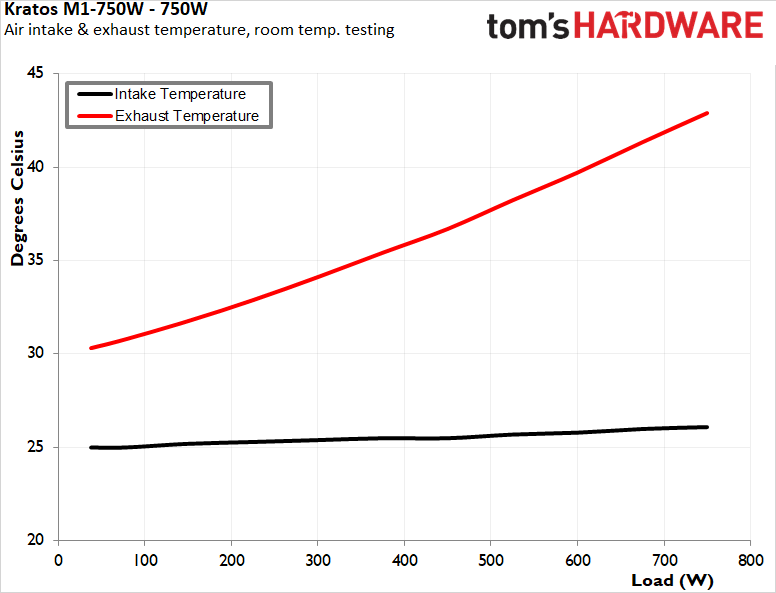

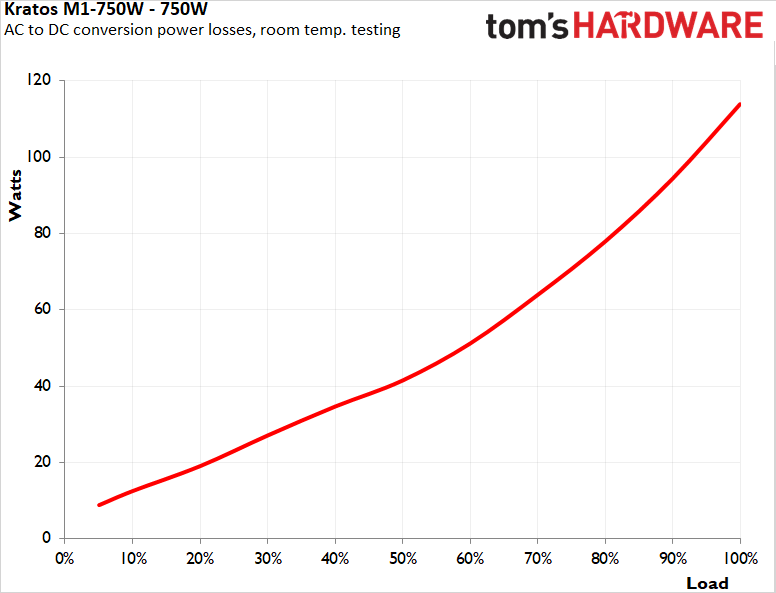

The energy conversion efficiency of the GAMDIAS Kratos M1-750W is right where we expected it to be for an 80Plus Bronze certified unit. It easily meets the certification’s requirements with an input voltage of 115 VAC, which is the input voltage this unit is certified at. Manufacturers commonly target their designs to meet the 80Plus certification requirements with an input voltage of 115 VAC due to the lower certification thresholds. The Kratos M1-750W just barely fails to meet the 80Plus Bronze requirements for an input voltage of 230 VAC, with an efficiency of 84.8% at full load. The average nominal load range (20% to 100% of the unit's capacity) efficiency of the unit is 87.4% with an input voltage of 230 VAC, which drops to 86.2% for an input voltage of 115 VAC.
The default cooling profile of the GAMDIAS Kratos M1-750W is predictably simple, with the thermal control circuit adjusting the speed of the fan primarily depending on the internal temperature of the unit. It is fairly silent when the load is very low but the low energy conversion efficiency translates to high losses, forcing the fan’s speed to quickly increase alongside with the load. The PSU will be noticeably audible at half load and becomes loud when heavily loaded.
Hot Test Results
Hot Test Results (~45°C Ambient)
The overall performance of all PC PSUs typically degrades once the ambient temperature rises, with various aspects affecting the magnitude of the drop. The average performance drop of the Kratos M1-750W is, for the most part, not bad for an 80Plus Bronze certified platform but the drop does become severe when the unit is heavily loaded, suggesting very high thermal stress. With an ambient temperature of about 45°C, the energy conversion efficiency drops to 85.5% for an input voltage of 230 VAC or to 84.3% for an input voltage of 115 VAC. The level of the drop is nearly tripled for loads greater than 90%.



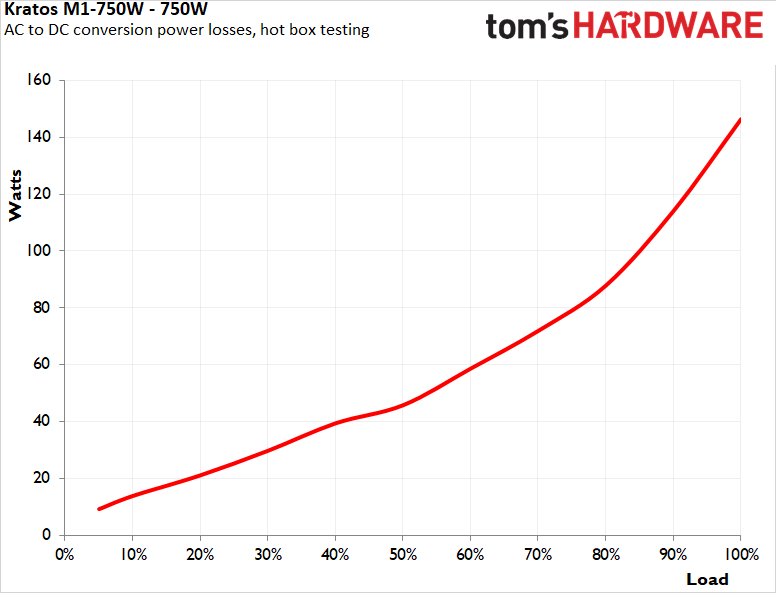

Expectably, the high ambient temperature means that the fan of the Kratos M1-750W will spin at high speeds even if the unit is lightly loaded. This is both due to the higher energy losses and the simplicity of this unit’s thermal control circuitry. The speed of the fan keeps increasing alongside with the load, trying to maintain operational temperatures within the unit. It reaches its maximum speed when the load is at about 600 Watts, beyond which point there is nothing more the fan itself can do. We should note that the design of the chassis allows hot air to escape within our hotbox (or a PC case, under normal working circumstances), limiting the efficiency of the cooling design because it forces the fan to intake the hot air it was just expelled from the numerous holes of the unit.
As we mentioned above, the high ambient temperature forces a high fan speed even if the unit is lightly loaded. The fan will generate more than 40 dB(A) even at minimum load, with that figure constantly increasing until the load is at about 600 Watts, at which point the fan reaches its maximum speed. At loads higher than 600 Watts, the internal temperatures of the Kratos M1-750W rise at a higher rate, reaching highly uncomfortable figures and explaining the extreme thermal stress that the unit’s components are exhibiting during these tests.
PSU Quality and Bottom Line
Power Supply Quality
The electrical performance of the GAMDIAS Kratos M1-750W is more complicated than usual. While the unit is not heavily loaded, the power quality is unsurprisingly mediocre, as expected of such a simple platform and low-priced unit.
| Load (Watts) | 152.97 W | Row 0 - Cell 2 | 378.88 W | Row 0 - Cell 4 | 562.88 W | Row 0 - Cell 6 | 748.79 W | Row 0 - Cell 8 |
| Load (Percent) | 20.4% | Row 1 - Cell 2 | 50.52% | Row 1 - Cell 4 | 75.05% | Row 1 - Cell 6 | 99.84% | Row 1 - Cell 8 |
| Row 2 - Cell 0 | Amperes | Volts | Amperes | Volts | Amperes | Volts | Amperes | Volts |
| 3.3 V | 1.87 | 3.4 | 4.67 | 3.38 | 7 | 3.35 | 9.34 | 3.32 |
| 5 V | 1.87 | 5.2 | 4.67 | 5.15 | 7 | 5.07 | 9.34 | 5.03 |
| 12 V | 11.21 | 12.21 | 28.02 | 12.1 | 42.03 | 11.99 | 56.04 | 11.97 |
| Line | Regulation (20% to 100% load) | Voltage Ripple (mV) | Header Cell - Column 3 | Header Cell - Column 4 | Header Cell - Column 5 | Header Cell - Column 6 | Header Cell - Column 7 |
|---|---|---|---|---|---|---|---|
| Row 0 - Cell 0 | Row 0 - Cell 1 | 20% Load | 50% Load | 75% Load | 100% Load | CL1 12V | CL2 3.3V + 5V |
| 3.3V | 2.1% | 26 | 20 | 24 | 40 | 24 | 24 |
| 5V | 3.6% | 20 | 16 | 20 | 44 | 46 | 26 |
| 12V | 2% | 20 | 32 | 40 | 106 | 38 | 30 |
But as we take our readings while the unit is operating inside our hotbox, the high thermal stress at maximum load wreaks havoc on the power quality figures of the PSU, which barely stay within the design guide recommended limits. As such, we can see the voltage ripple on the major 12V line exploding from 40 mV all the way to over 100 mV over just 20% of the entire loading range.
Cross-loading the unit also causes the minor lines to fluctuate heavily, a distinct feature of all group-regulated platforms. Newer group-regulated platform designs are significantly improved, but they are not capable of entirely overcoming that obstacle. As modern systems heavily rely on the 12V line alone, this means that the chance of having poor power quality in a modern system is very high. Voltage regulation is passable, at 2% on the 3V and 12V lines, and 3.6% on the 5V line.
As part of our standard testing, we test the primary protections of all PSUs we review (Over Current, Over Voltage, Over Power, and Short Circuit). All of the protections of the GAMDIAS Kratos M1-750W engaged. The OPP protection is set a bit high, at about 120% of the unit’s rated capacity, which is not abnormally high for typical designs but it is placing unnecessarily high stress on a unit that runs at such high temperatures.
Bottom Line
The Kratos M1-750W power supply unit exhibits a mixture of strengths and weaknesses that should be carefully considered by potential buyers. When assessing its build quality, it becomes apparent that it falls into the category of average. The OEM/ODM behind the Kratos M1-750W is Andyson, a reputable designer and manufacturer of PC PSUs, but it is important to highlight that this power supply relies on an older platform with only minor upgrades and outdated topologies. This aspect may impact its long-term viability and compatibility with newer hardware. While the capacitors used in this unit do not originate from well-known Japanese brands, it is worth noting that they are of good quality, as most of the unit’s critical components are.
Power quality is a crucial factor for any PSU, and the Kratos M1-750W delivers middling-but-acceptable power quality, which aligns with its low-cost positioning. Voltage filtering is passable under normal operating conditions but can deteriorate significantly when the PSU is heavily loaded for prolonged periods, primarily due to thermal stress. Moreover, the voltage regulation is only average, and its cross-load performance suffers due to the group regulation topology. In terms of energy efficiency, it merely meets the 80Plus Bronze requirements, without any remarkable performance by today's standards.
Thermal performance is another area of concern, as the Kratos M1-750W tends to operate at high temperatures, especially when subjected to heavy loads in hot environments. This was not unforeseen, but it can potentially affect its long-term reliability and lifespan. Noise levels also come into play, with the unit remaining virtually noiseless when operating in a cool environment under low loads. However, noise levels can escalate significantly under heavy loads, particularly within hot environments, which may not be ideal for users seeking a quiet computing experience.

Finally, when evaluating the value proposition of the Kratos M1-750W, it becomes clear that its normal retail price of $80 is not a good match for the performance it offers. Either GAMDIAS or Amazon seems to be aware of this as well, and as a result the latter currently has the PSU on sale for a much more wallet-friendly $60.
Overall, the Kratos is aimed as system builders who are after a budget power supply, but still want to prioritize extravagant aesthetics and addressable RGB lighting over performance and efficiency. All which is a valid market, but it makes pricing critical, since under the hood it's still an entry-level 80Plus Bronze design in a hyper-competitive segment. To that end, at its current sale price the Kratos is likely to find a niche among mid-range PC builders looking for a visually striking PSU. Otherwise, builders seeking better power performance and/or intend to use high-end GPUs should be advised to aim a bit higher.
MORE: Best Power Supplies
MORE: How We Test Power Supplies
MORE: All Power Supply Content

Dr. E. Fylladitakis has been passionate about PCs since the 8088 era, beginning his PC gaming journey with classics like Metal Mutant and Battle Chess. Not long after, he built his first PC, a 486, and has been an enthusiast ever since. In the early 2000’s, he delved deeply into overclocking Duron and Pentium 4 processors, liquid cooling, and phase-change cooling technologies. While he has an extensive and broad engineering education, Dr. Fylladitakis specializes in electrical and energy engineering, with numerous articles published in scientific journals, some contributing to novel cooling technologies and power electronics. He has been a hardware reviewer at AnandTech for nearly a decade. Outside of his professional pursuits, he enjoys immersing himself in a good philosophy book and unwinding through PC games.
-
logainofhades Replytoffty said:TLDR: Get a Seasonic PSU and never worry.
Seasonic has had some duds over the years too. -
USAFRet Reply
Why curse someone else? Do you not like them?triplex1 said:If they gave it to me as a gift, I would also give it as a gift later -
triplex1 Reply
No one will say anything, they will tell me and thank youUSAFRet said:Why curse someone else? Do you not like them? -
micheal_15 Did they call it Kratos because you'd go to war with anyone that gave you this as a gift?Reply



